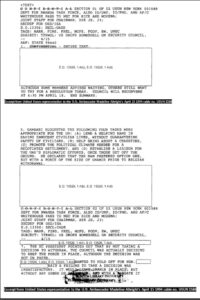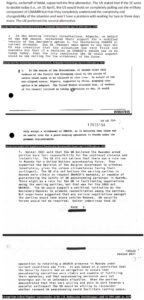- About Ramapo
- Academics
- Admissions & Aid
- Student Life
- Athletics
- Alumni
- Arts & Community
- Quick Links
- Apply
- Visit
- Give
Kwibuka 30, Panel 9
Madeleine Albright writes to the US secretary of State that it appears that it might be an opportunity to evacuate UNAMIR forces as a short calmness fell upon Kigali, and if they wait to pull out, it will be harder without ¨French and Belgian troops. She continues, “It is worth considering taking the lead in the Security Council to authorize the evacuation of the bulk of UNAMIR while leaving behind a skeletal staff.” Click to enlarge.
The Failure of the UN Assistance Mission in Rwanda (UNAMIR) and its Legacies
The United Nations Assistance Mission for Rwanda (UNAMIR) was hindered in its outcomes by its restrictive mandates, inadequate resources, and fatal miscommunications. This mission’s goal was to preserve peace and protect civilians, but it was crippled in its ability to avert the impending catastrophe. Resolution 872, outlining UNAMIR’s mandate, confined its operations to observation and reporting, prohibiting proactive intervention to prevent escalations of violence or to safeguard vulnerable civilians.
The consequences of these limitations were felt by everyone in Rwanda. UN peacekeepers found themselves outmanned and out-armed, unable to shield designated safe areas. Schools and shelters meant to provide refuge became sites of brutal massacres as peacekeepers, overwhelmed and under-equipped, withdrew their protection. Miscommunications within the UN further exacerbated the crisis. As the genocide unfolded, appeals for increased deployments were denied. The withdrawal of key contributing nations, notably Belgium and the United States, further eroded UNAMIR’s already fragile capacity to protect civilians in armed conflict. The failure of UNAMIR had devastating consequences, particularly for the Tutsi minority. Abandoned by the international community as UN troops withdrew, Tutsi faced not only the horrors of genocide but also racial profiling during attempted flight. Western states prioritized the safety of their own nationals, leaving vulnerable Rwandans to fend for themselves.
The failure of international institutions in the 1994 Genocide Against the Tutsi prompted a proactive shift in UN peacekeeping practices. Resolutions like 918 empowered peacekeepers to use force for self-defense and civilian protection as a last resort, expanding their roles beyond mere observation. As we reflect on this dark chapter, the resounding lesson for the UN is clear: commit to robust civilian protection within peacekeeping missions and ensure ample support to prevent similar catastrophes in the future.
Quick Links
UN Assistance Mission in Rwanda
Archival Documents in Rwanda Genocide
National Security Archive U.S. and The Rwandan Genocide
Bibliography
Blanton, Tom, and Emily Willard. “1994 Rwanda Pullout Driven by Clinton White House, U.N. Equivocation.” The National Security Archive. April 16, 2015.
Cinq-Mars, Evan. “Twenty Years of Prioritizing the Protection of Civilians: Painful Lessons from Rwanda Remain Relevant for UN Peacekeeping Operations Today.” Center for Civilians in Conflict. April 5, 2019.
Davis, Rachel, Benjamin Majekodunmi, and Judy Smith-Höhn. “Case Studies of Genocide and Mass Atrocities.” JSTOR. 2008.
Harvard Kennedy School’s Institute of Politics. “Ghosts of Rwanda.” March 24, 2004. YouTube, 01:39:40.
“Interactive: Rwanda Genocide.” Aljazeera. April 14, 2014.
Photo Source
“1994 Rwanda Pullout Driven by Clinton White House, U.N. Equivocation.” 2015. The National Security Archive.
Copyright ©2025 Ramapo College Of New Jersey. Statements And Policies. Contact Webmaster.



Follow Us!